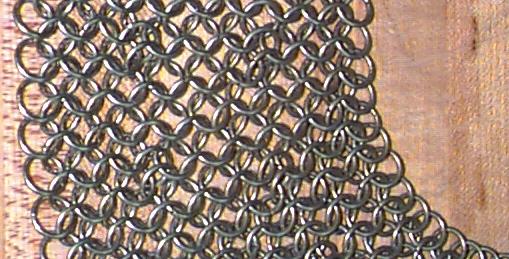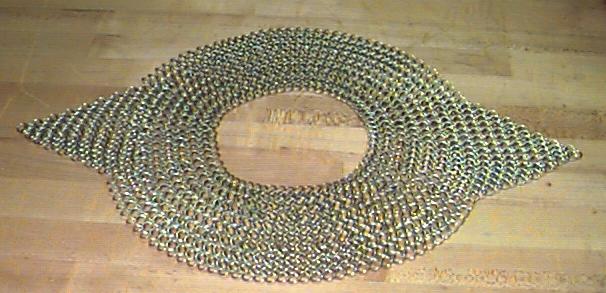In order to build any piece of maille that is meant to cover an increasingly large area (e.g. from the neck to the shoulders), it is necessary to find some way to expand the maille without leaving holes or unsightly seams. One way to do this is to employ diverging links. Such is the case with the Bishop's Mantle, a piece a maille that covers the shoulders and lower neck.
In a normal piece of 4-in-1 European maille, each link in a row is connected to 2 links above and 2 below. A diverging link, however, connects to the usual two links below, but only one above. In this example, rows of 7 links are expanded to rows of 10 links using a connecting row where a diverging links is used in between every 2 normal links. Here diverging links are shown as ovals for clarity.
Here is a closeup picture of these expanding rows. There are expanding links in every fifth row.

Build five rows of links just long enough to fit over your head when the ends are connected to together (note the number of rings in each row). Build a second set of five rows with exactly 1 and 1/3 times as many links. connect these two sets of rows together using a single row with one link diverging for every three normal. In this example a set of 18 link rows is expanded once to 24 links and then again to 32 links. This makes a total of 17 rows. Each row is connected back on itself to complete the mantle (i.e. A- A, B-B and C-C).
This example just shows the basic ratios involved in the mantle. A more realistic (very much so as I have built one this way) pattern using 5/16" 16 awg links would be a set of five rows of 63 links, expanded one for every three to five rows of 84 links, and then expanded again to five rows of 112 links.
This will give you a basic bishop's mantle. A touch of style can be added by putting dags (chainmaille triangles) in steel or brass along the lower edge of the mantle. A completed mantle is shown below.
